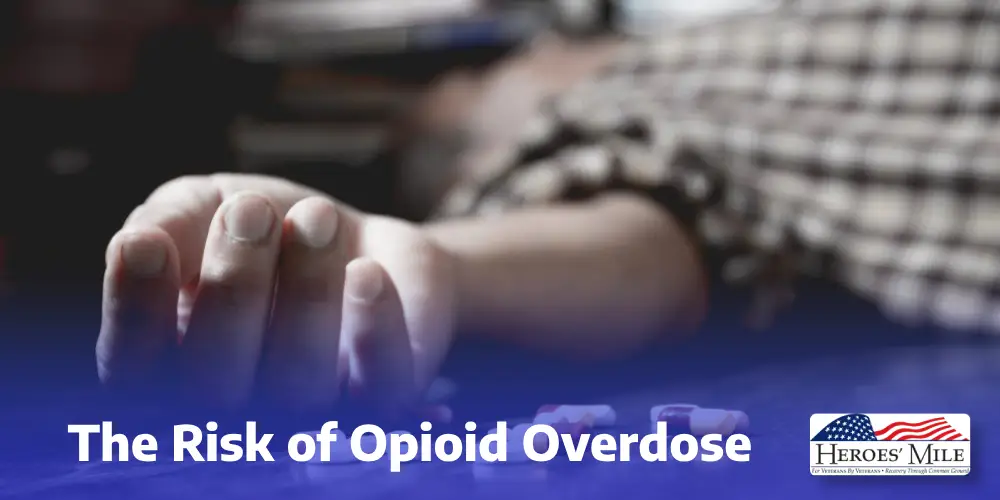Pain is a universal experience, but some deal with it more often than others. Every year in the United States, as many as 50 million people fill at least one opioid prescription for pain relief. Of the 20 percent who go on to abuse their prescriptions, their misuse will lead to addiction for a third of them. Such a high rate of drug abuse amongst prescription opioids begs the question: just how addictive are painkillers?
Individuals with Chronic Pain
Veterans are statistically more likely to experience chronic pain than their civilian counterparts. The exact reason for this discrepancy varies, though it isn’t difficult to imagine why. Veterans may develop chronic pain through a service-related injury, military sexual trauma (MST), or the sheer stress caused by combat exposure, none of which are hardships civilian have to face.
As a result of these experiences, it’s understandable that veterans have a predisposition to chronic pain. Unfortunately, this also places veterans at an increased risk of developing an opioid addiction. How? A higher level of pain means a higher need for pain relief. To meet those needs, veterans receive prescribed opioid medications more frequently than civilians.
The larger number of opioid prescriptions written for veterans means they receive more opportunities to abuse the drugs. Of course, this doesn’t mean all veterans abuse prescriptions, as it’s possible to fill a prescription for an opioid medication without misusing it.
However, it’s impossible to deny the high rates of abuse when it comes to prescription opioids. It leaves many people asking, “How addictive are painkillers?” as well as “Do I have an opioid addiction?” and “How do I treat opioid addiction?”
Keep reading for answers to all of these questions and more.
How Addictive Are Painkillers?
The short answer is that opioid medications tend to be highly addictive. That’s not to say that opioid painkillers can’t be prescribed and taken safely, but it does mean that it’s important to educate oneself on the risks and warning signs of addiction before taking them.
The Science of Addiction
Some people mistakenly believe that those who struggle with drug addiction should simply be able to stop. In reality, addiction goes much deeper than that. It fundamentally alters the users brain to make the drug’s continued use as rewarding as possible, while also leaving the brain unable to function properly in its absence. This can be broken down into a few key terms: tolerance, dependence, and addiction.
When a person regularly takes a drug over long periods of time, their body adapts by developing a tolerance for it. What this means is that the same dosage of the drug will gradually become less effective as the body grows accustomed to its effects. In turn, the user will have to increase their dosage to achieve the same “high” as before.
The body can grow so accustomed to the drug, in fact, that it then develops a dependence on it. After the establishment of a physical dependence, the drug’s removal becomes much more challenging. The body no longer remembers how to function without it, so losing it would trigger unpleasant withdrawal symptoms.
Opioid Dependence
For opioid medications, tolerance and dependence build as a result of how the drug interacts with the body’s opioid receptors. As the medications move through the bloodstream, they link up with unique proteins in the brain that are designed to receive opioids. But how addictive are painkillers, and how does that addiction happen?
The process is surprisingly simple. Once the opioids and their receptors connect, their bonding has the same effect on the brain as activities like eating and sex. In other words, it releases dopamine, which is a chemical in the brain associated with the feeling of pleasure.
If someone takes opioids for pain as intended, this pleasure works to combat the pain, which is why they make such effective pain relief tools. The issue with prescription opioids arises when someone takes them for too long or in the absence of pain, and the pleasure they cause then becomes the body’s new standard.
Once the “high” becomes normal, “normal” starts to feel much lower than it should be, and users continue taking prescription drugs to avoid it. Thus, a dependence on opioids is born, and this chronic misuse leads to addiction.
Signs of Opioid Addiction
Once you’ve asked, “How addictive are painkillers?” your next question may pertain to what opioid addiction looks like in effect and how to spot it. In that regard, there are a number of red flags associated with drug addiction. Most of them fall under one of three categories of influence: physical, mental, or social.
The side effects of prescription drug abuse target and harm all three. Thus, all three must undergo assessment together when attempting to determine whether someone struggles with an opioid addiction.
Signs that indicate a potential drug addiction include:
Presence of withdrawal symptoms if the drug isn’t taken
Inability to limit/stop usage, even if desired
Drug cravings
Magnified depression or anxiety
Isolation or loss of interest in hobbies
Strained relationships with family and friends
Worsened performance at work or school
Continued use of the drug despite these adverse effects
If you experience any of these symptoms or generally feel as though your drug intake has a negative impact on your life, it may be time to seek help. Opioid addiction threatens your physical and mental health, and it can damage your relationships and livelihood if left unattended.
Thankfully, help is only ever a phone call away. The staff members at Heroes’ Mile are always prepared to welcome you into our facility and greet you with a comprehensive treatment plan built just for you.
The Risk of Opioid Overdose

The Risk of Opioid Overdose
One reason prescription drug misuse is so dangerous involves the growing prevalence of opioid overdose. In 2019, an estimated 38 people died from an opioid-related overdose every day. This means that throughout the course of the year, over 14,000 overdose deaths occurred in the United States alone.
According to the National Institute on Drug Abuse, potential warning signs of an opioid overdose include:
- Unconsciousness
- Pinpoint pupils
- Shallow or irregular breathing
- Limp body
- Pale, clammy skin
- Purple lips or fingernails
Please note that an overdose is a medical emergency. If you suspect one, call 911 immediately.
Opioid Addiction Treatment
Heroes’ Mile provides treatment programs that are individually tailored to suit every patient’s unique needs. For this to occur, you will first go through an evaluation by one of our dedicated addiction specialists. Together, you will discuss your goals and the best options available to help you achieve them.
If a physical dependence on opioid medications gets identified, the first step of treatment will likely be a drug detoxification. In this five to seven day process, the addictive substance will exit your system, and your body will relearn how to function without it. Our doctors will monitor your status closely throughout this time and help lessen the impact of any withdrawal symptoms you may experience.
We prioritize your safety and comfort from day one. By providing a calm and secure environment in which you can detox without worry, we can begin the healing process on a strong, positive note.
Following detox, you may enter our residential rehabilitation program. This is an intensive program that will see you learning healthy skills for pain management as well as help you adjust back to life as a civilian. The transition from military living can be jarring, but with the proper time and resources allotted by Heroes’ Mile, you can re-establish a balanced, healthy life without having to rely on opioid medications.
A few examples of the treatments you may try during residential rehab include:
- 12-step programming
- Eye movement desensitization and reprocessing (EMDR) therapy
- Cognitive behavioral therapy
- Group therapy
- Peer-to-peer veteran support
No matter what trials you face or what questions you have, from “How addictive are painkillers?” to “How long do withdrawal symptoms last?” we at Heroes’ Mile are here to help with any concerns. We will find what works best for you and stay by your side on your journey to recovery.
Remember that sobriety is never beyond your grasp. By reaching out for the aid you need, you can take back control of your life.
Video
What You Should Know About Opioids and Painkillers, Body Stuff with Dr. Jen Gunter – TED Talk
Pain is your body’s signal that something isn’t right. To help manage it, doctors often prescribe powerful opioids — but they’re not always the best option and can quickly lead to addiction. Illuminating the fine line between substance use and abuse, Dr. Jen Gunter explains what opioids do to your perception of pain, the risks they pose and the questions to ask your doctor about them. – watch at YouTube
News Audio
Over-the-counter pain medications 101 – NPR
Pain is a part of the human experience. We get cramps and aches and migraines. We burn our hands cooking or trip and sprain an ankle. And when you’re right in the middle of one of these moments and feeling that pain deep down in your bones, painkillers – especially the over-the-counter kind that are easy to get – they feel like a miracle. Now, they are not without risks. If you take over-the-counter painkillers the wrong way or take too many of them, you can have serious complications or even die. And they can mask your problems, too. Pain is there for a reason. It’s one of the ways our bodies warn us that something’s wrong. Dr. Trisha Pasricha is an instructor at Harvard Medical School, and she says we need to consider that when we’re thinking about taking painkillers.
FAQ
1. Why are painkillers so addictive?
Painkillers, especially opioids, trigger the brain’s reward system by releasing dopamine, which creates feelings of pleasure and pain relief. Over time, the brain may rely on the drug, leading to physical and psychological dependence.
2. Which painkillers are most addictive?
Opioid medications like oxycodone, hydrocodone, morphine, and fentanyl are among the most addictive. Even when taken as prescribed, they carry a high risk for addiction.
3. How can I tell if someone is addicted to painkillers?
Signs include taking more than prescribed, withdrawal symptoms between doses, mood swings, secrecy about medication use, and neglecting responsibilities.
4. Can someone become addicted even if they take painkillers as prescribed?
Yes. Long-term use, high doses, or a personal or family history of addiction can increase the risk—even when following a doctor’s instructions.
5. What are safer alternatives to opioid painkillers?
Non-opioid medications, physical therapy, acupuncture, cognitive behavioral therapy, and lifestyle changes like exercise and stress management can be effective alternatives for managing chronic pain.
